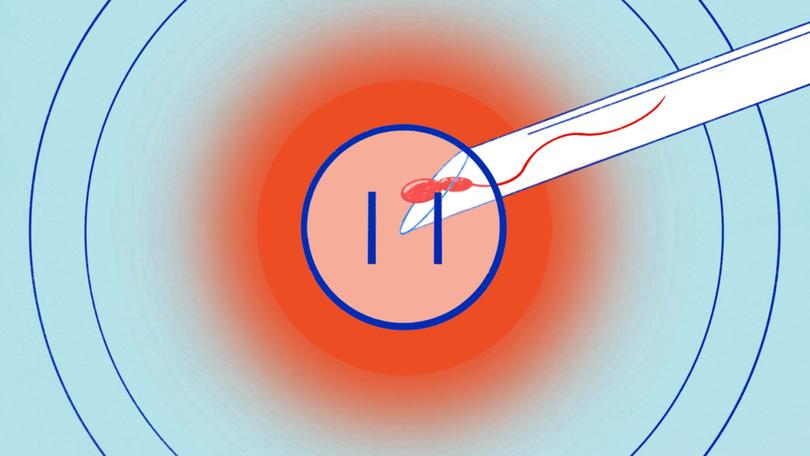Cost of living crisis snuffing the dreams of thousands of hopeful Australian parents, new report suggests

The cost of living crisis is snuffing the dreams of thousands of hopeful Australian parents. Surging costs are putting pricey fertility treatments such as IVF and egg freezing out of reach, say experts.
New figures released by the Australian and New Zealand Assisted Reproduction Database on Friday show 2.3 per cent fewer women initiated IVF fertility treatments in 2022 than in 2021, with initiated IVF cycles falling from 109,840 in 2021 to 107,316 in 2022.
There was a 3 per cent decline in the number of babies born from IVF treatment in 2022 — down from 20,690 in 2021 (with 20,440 liveborn babies) to 20,058 (with 19,833 liveborn).
Sign up to The Nightly's newsletters.
Get the first look at the digital newspaper, curated daily stories and breaking headlines delivered to your inbox.
By continuing you agree to our Terms and Privacy Policy.Lead author of the report Georgina Chambers from the University of NSW said a reason for the decline could partly be attributed to the cost of living crunch.
“It’s a significant out-of-pocket cost, around $3000-$5000 per IVF cycle,” Professor Chambers said.
“Many women and couples have to undergo multiple IVF cycles and sadly some may never achieve a pregnancy, so there’s a lot of women who have to keep finding that money again and again for a chance to get their baby.”
Australia’s fertility rate dipped to a record low of 1.63 babies per woman in 2022. It triggered many worried appeals for women to get procreating; even Treasurer Jim Chalmers said the country’s economic outlook would be “better if birth rates were higher”.
One in six Australian couples of reproductive age (between 15 and 44) is affected by infertility — ANZARD reports more than 56,000 intending parents (solo and coupled) initiated assisted reproductive treatment (ART) in both 2021 and 2022.
But fertility treatments can cost thousands of dollars and vary greatly.
According to IVF Australia, one cycle can cost a patient upwards of $10,000 — and at least $5000 out of pocket, on average. Freezing and storing eggs and embryos costs hundreds, if not thousands, of dollars alone.
It’s not a price that many can afford to pay with inflation pressing down on household budgets, especially when success is not guaranteed.
Even so, Prof Chambers said despite the dip in treatment cycles, Australia’s ART success rates continue to climb.
Over a third (38.9 per cent) of women in Australia and New Zealand achieve a live birth in their first complete cycle (that is, from all embryo transfers resulting from an egg retrieval). In 2021, 37.1 per cent of women achieved a live birth in their first complete cycle.
After six complete ART cycles, women had a 59.5 per cent chance of achieving a live birth (up from 57.1 per cent in 2021).
Prof Chambers said that success rates from IVF continue to increase and depend on many things including a woman’s age and number of previous failed cycles.
She said it was particularly pleasing that this growing success comes against a backdrop of increasing single embryo transfers — up from 90.6 per cent in 2018 to 94.2 per cent in 2022 — which reduces the risk of twins and is, therefore, much safer for mothers and babies.
More couples were opting to freeze their embryos and eggs in 2022, with the number of “freeze-all cycles” almost doubling, rising 15.8 per cent annually from 13,520 in 2018 to 24,099 in 2022.
More single women in particular were using ART to preserve their fertility. There were 6899 fertility preservation cycles reported to ANZARD in 2022, up 89 per cent from 2020, and more than one-third (38.1 per cent) of them were for non-medical reasons.
“Women are increasingly freezing their eggs as a way of preserving their fertility, mostly because they haven’t found a suitable partner,” Prof Chambers said.
“It’s not necessarily that they’re putting their career or other things first. These women want a baby, but they haven’t found a partner to parent with yet.”
A total of 2626 women froze their eggs for non-medical reasons in 2022, with the procedure most popular among women aged between 35 and 39.
Of the 1220 initiated cycles in 2022 that were not for infertility, 37.9 per cent resulted in live births.
Prof. Chambers said while there was “enormous” interest in fertility preservation in recent years, it was important women knew egg freezing was not a “complete insurance policy”.
“Fertility preservation has its place as long as women understand that it’s not a complete insurance policy, everything still has to go the right way for those eggs to turn into babies — and their chances are about the same as normal IVF.”
